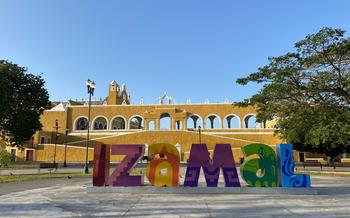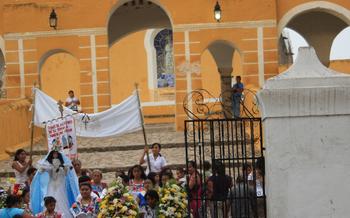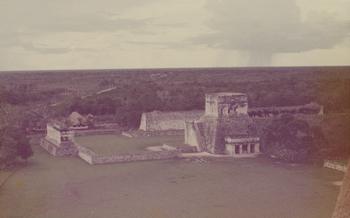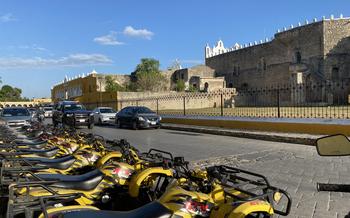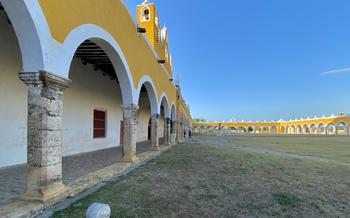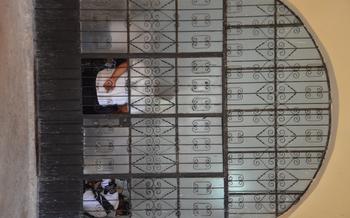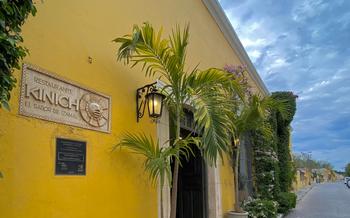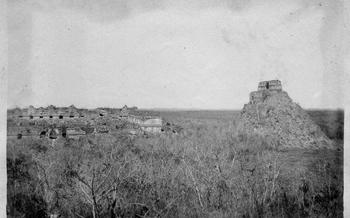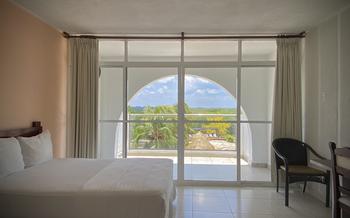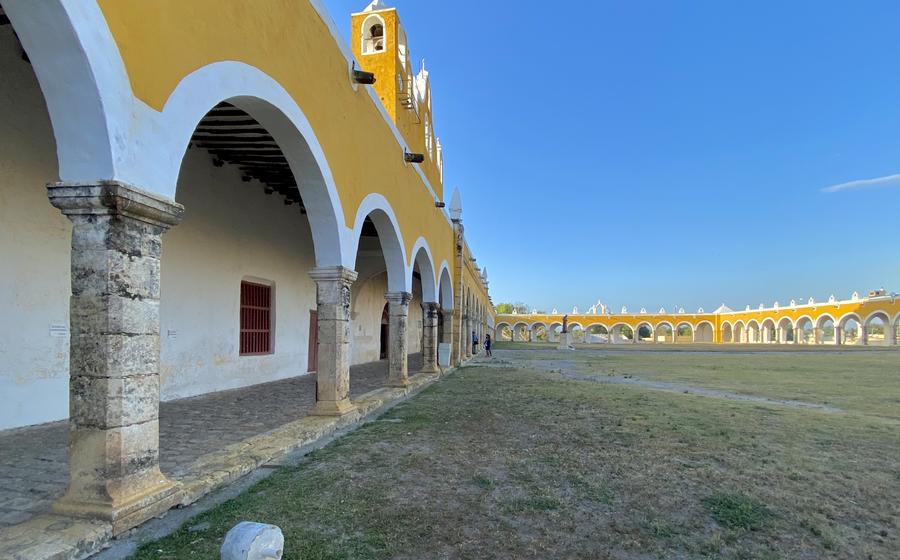
Pirámide de Itzamatul
- Pirámide de Itzamatul: A Majestic Mayan Pyramid
- Exploring the Pyramid's Interior
- The Surrounding Archaeological Zone
- The Ancient City of Izamal
- Interactive Exhibits and Displays
- Booking Guided Tours
- Local Cuisine and Restaurants
- Photography Tips and Regulations
- Accommodations and Hotels
- Transportation Options
- Shopping and Souvenirs
- Safety and Security
- Language and Communication
- Weather and Climate
- Insider Tip: Hidden Cenotes
Pirámide de Itzamatul: A Majestic Mayan Pyramid
The Pirámide de Itzamatul stands as a testament to the architectural prowess and cultural significance of the ancient Maya civilization. Constructed in the 7th century AD, this awe-inspiring pyramid served as a religious and ceremonial center for the people of Izamal. With a height of approximately 35 meters, it is the tallest structure in the ancient city and offers panoramic views of the surrounding landscape. The pyramid's construction showcases intricate stonework and features a series of steep steps leading to a temple at its summit. Dedicated to the Maya god Itzamna, the pyramid holds immense religious and cultural importance, attracting visitors from around the world. Planning a visit to this iconic landmark requires careful consideration, ensuring a safe and enriching experience while respecting the site's historical significance.
Exploring the Pyramid's Interior
Venturing into the Pirámide de Itzamatul's interior is a unique and awe-inspiring experience. The pyramid's chambers, accessible through a narrow entrance, offer a glimpse into the ancient Maya's intricate belief system and rituals. Inside, visitors can admire well-preserved murals and carvings that depict Mayan deities, rulers, and scenes from their daily lives. These artistic masterpieces provide valuable insights into the cultural and religious practices of this enigmatic civilization.
For safety reasons, exploring the pyramid's interior is only permitted with a licensed guide. These guides are knowledgeable experts who can provide detailed explanations of the pyramid's history, architecture, and significance. They will also ensure that visitors follow safety protocols, such as wearing helmets and using proper lighting, to minimize any risks while exploring the pyramid's confined spaces.
The Surrounding Archaeological Zone
The Pirámide de Itzamatul stands as the centerpiece of an extensive archaeological zone, revealing the grandeur of the ancient Mayan city that once thrived here. Scattered around the pyramid are the remains of other significant structures, including temples, palaces, and residential complexes, each holding a story of its own. These ruins provide a glimpse into the daily lives, rituals, and social organization of the Maya who called this place home.
The surrounding complex once served as a religious and administrative center, with the pyramid as its focal point. The arrangement of the structures suggests a well-planned urban layout, with streets, plazas, and courtyards connecting the various buildings. Archaeologists continue to uncover new insights into the city's layout and functions as they conduct ongoing excavations and research in the area.
Exploring the archaeological zone offers a deeper understanding of the ancient Maya civilization. Visitors can wander among the ruins, imagining the bustling streets and vibrant ceremonies that took place centuries ago. The intricate carvings and decorative elements on the buildings provide clues about Mayan history, mythology, and artistic traditions. With each step, visitors can feel a connection to the past, gaining a deeper appreciation for the ingenuity and legacy of the Maya.
The Ancient City of Izamal
The city of Izamal holds a rich and fascinating history, dating back to the pre-Hispanic era. Founded around the 7th century AD by the Itza Maya, Izamal was once a thriving metropolis and a major religious center in the Maya world. The city's name, meaning "dew from heaven," reflects its significance as a sacred place.
Izamal's most striking feature is its unique yellow architecture, which gives it the nickname "Ciudad Amarilla" or "Yellow City." This distinctive color comes from the limestone used in the construction of many buildings, which contains a high concentration of a mineral called calcite. The yellow hue creates a warm and inviting atmosphere, making Izamal a visually captivating destination.
In addition to its yellow architecture, Izamal is home to several cultural attractions and landmarks that showcase its rich heritage. The city's main square, known as the Plaza de la Constitución, is surrounded by historic buildings, including the majestic Catedral de San Antonio de Padua, a 16th-century Franciscan church that dominates the skyline.
Izamal is also renowned for its vibrant local festivals and events, which celebrate the city's unique traditions and culture. The most famous festival is the Carnival de Izamal, a lively celebration that takes place every year before Lent. During the carnival, the streets of Izamal come alive with colorful costumes, parades, music, and dancing, creating an unforgettable experience for visitors.
Interactive Exhibits and Displays
The ancient city of Izamal is home to several museums and visitor centers that offer interactive exhibits and displays showcasing the rich history and culture of the Mayans. These facilities provide an immersive experience for visitors, allowing them to delve deeper into the significance of the pyramid and the surrounding archaeological zone.
One of the most notable museums is the Museo de la Cultura Maya, which houses an extensive collection of artifacts and exhibits related to the Maya civilization. Visitors can admire intricate pottery, sculptures, and jewelry, gaining insights into the artistic and craftsmanship skills of the ancient Maya. The museum also features interactive displays that allow visitors to experience traditional Maya rituals and customs, such as the use of incense burners and the performance of ceremonial dances.
For those interested in learning more about the specific history and significance of the Pirámide de Itzamatul, the Centro de Interpretación de la Pirámide de Itzamatul offers a comprehensive overview of the site. Through multimedia presentations and interactive displays, visitors can explore the pyramid's construction techniques, its role in Maya religious ceremonies, and its importance as a symbol of power and authority.
These interactive exhibits and displays not only educate and inform visitors but also provide a fun and engaging way to experience the rich cultural heritage of the Mayans. They offer a unique opportunity to connect with the past and gain a deeper appreciation for the significance of the Pirámide de Itzamatul and the ancient city of Izamal.
Booking Guided Tours
To truly delve into the history and significance of the Pirámide de Itzamatul, consider booking a guided tour. Local guides offer a wealth of knowledge and insights that can enhance your experience. They can provide historical context, explain the pyramid's architectural features, and share stories about the ancient Maya civilization.
Guided tours are available in various languages and can be tailored to your interests and preferences. Some tours focus specifically on the pyramid, while others include visits to other nearby ruins and attractions. Prices and durations vary depending on the tour operator and the itinerary. Advance booking is recommended, especially during peak tourist season.
By hiring a local guide, you'll gain a deeper understanding of the pyramid's significance and its place within the ancient Mayan city. Guided tours offer a personalized and informative experience that will leave you with lasting memories.
Local Cuisine and Restaurants
The culinary delights of Izamal are an integral part of the city's charm, showcasing the rich flavors and traditions of the region. Indulge in authentic Mayan dishes that have been passed down through generations, blending ancient culinary practices with modern-day ingredients.
Must-try dishes include cochinita pibil, a slow-cooked pork marinated in achiote and wrapped in banana leaves, and panuchos, fried tortillas topped with black beans, shredded turkey, and a zesty tomato sauce. Don't miss the opportunity to savor fresh seafood, as Izamal is known for its proximity to the coast.
Explore the local markets to discover an array of street food options, from freshly made tortillas and tamales to exotic tropical fruits. For a sit-down dining experience, head to one of the many family-run restaurants that line the city's colorful streets.
For vegetarians and those with dietary restrictions, there are plenty of options available. Many restaurants offer vegetarian versions of traditional dishes, and there are also a number of dedicated vegetarian and vegan restaurants in the city.
When it comes to local cuisine in Izamal, embrace the opportunity to embark on a culinary adventure, sampling the diverse flavors and delights that this vibrant city has to offer.
Photography Tips and Regulations
The Pirámide de Itzamatul and its surroundings offer a treasure trove of photo opportunities. To capture the best shots, arrive early in the morning or late in the afternoon to avoid harsh lighting and take advantage of the golden hour's warm hues. Remember to be respectful of the site's cultural significance and follow any regulations regarding photography. Using tripods and flash photography may be restricted in certain areas, so be prepared to adjust your settings accordingly.
To capture the pyramid's majestic scale, use a wide-angle lens. Experiment with different angles and perspectives to showcase its grandeur against the backdrop of the surrounding landscape. For close-up details of the intricate carvings and sculptures, switch to a telephoto lens.
If you're an avid birdwatcher, bring your binoculars to spot the diverse bird species that inhabit the area. Wildlife photography enthusiasts may also encounter iguanas, lizards, and other creatures. Remember to maintain a respectful distance and avoid disturbing the wildlife.
Drones offer a unique perspective, but be mindful of regulations and restrictions. Obtain the necessary permits and operate your drone responsibly, respecting the privacy of other visitors and the tranquility of the site.
Accommodations and Hotels
Izamal offers a range of accommodation options to suit every traveler's budget and preferences. From charming haciendas and boutique hotels to cozy guesthouses and hostels, there's something for everyone.
For a truly authentic experience, consider staying in one of the many haciendas that dot the city. These historic estates have been lovingly restored and offer a glimpse into Izamal's rich past. Many haciendas feature beautiful gardens, swimming pools, and even on-site restaurants.
Budget travelers will find plenty of affordable options in Izamal. Several hostels and guesthouses offer dorm-style accommodations and private rooms at reasonable rates. These establishments often have communal kitchens and lounge areas, providing opportunities to socialize with fellow travelers.
Families and groups might prefer to rent a vacation home or apartment. These spacious accommodations offer privacy and flexibility, with amenities like fully equipped kitchens and multiple bedrooms.
When choosing a hotel or accommodation in Izamal, consider your proximity to the pyramid and other attractions. The city center is relatively compact, so most places are within walking distance of the main sights. However, if you plan on exploring the surrounding area, having a rental car or access to public transportation is recommended.
Transportation Options
Reaching Izamal from larger cities in Mexico presents several transportation options. Rental cars provide flexibility and allow for exploration of the surrounding area at your own pace. Rental agencies are available at major airports and cities, and driving directions to Izamal are straightforward.
Public transportation offers a budget-friendly alternative. Buses depart from various cities, and the journey usually takes several hours. While slower than driving, buses offer a chance to soak in the scenery and interact with locals.
Taxis are readily available at airports and bus stations in Izamal. They offer a convenient and direct mode of transport to your hotel or other destinations within the city. Negotiate the fare in advance to avoid surprises.
When selecting your transportation, consider your budget, time constraints, and personal preferences. Whether you prefer the freedom of driving, the affordability of buses, or the convenience of taxis, there's an option to suit every traveler.
Shopping and Souvenirs
Izamal offers a vibrant shopping scene, where visitors can find unique souvenirs and handmade items to cherish their trip. The local markets and craft shops are a treasure trove of traditional textiles, colorful handicrafts, and authentic Mayan souvenirs. Visitors can bargain with the friendly vendors to get the best prices and support local artisans. Bargaining is not only expected but also considered a fun part of the shopping experience. Remember to be respectful and offer a fair price that reflects the time and effort put into creating these beautiful items. By supporting local artisans, you not only take home a piece of Izamal's culture but also contribute to the preservation of traditional crafts and livelihoods.
Safety and Security
Exploring Izamal is generally safe for tourists, but it's essential to exercise caution and be aware of your surroundings. Here are some safety tips to keep in mind:
-
Be vigilant and avoid isolated areas, especially at night.
-
Keep your valuables secure and avoid carrying large amounts of cash.
-
Inform your hotel or tour guide of your plans and check in regularly.
-
Be cautious of pickpockets and scams, particularly in crowded areas.
-
Respect local customs and traditions to avoid any misunderstandings.
-
Learn basic Spanish phrases to communicate with locals and ask for assistance if needed.
-
Stay informed about local news and events to be aware of any potential risks or disruptions.
In case of an emergency, dial 911 or seek help from local authorities. It's also advisable to have travel insurance that covers medical emergencies and unexpected events.
Language and Communication
Spanish is the predominant language spoken in Izamal, with Yucatec Maya also present among the local population. To facilitate communication, it is helpful to learn a few basic Spanish phrases, such as greetings, numbers, and directions. The locals are generally friendly and welcoming, and many are willing to help even if you don't speak Spanish fluently. If you encounter any language barriers, consider using a translation app or hiring a guide who can assist you. Mobile connectivity and internet access are widely available in Izamal, allowing you to stay connected and use online resources for translation or navigation.
Weather and Climate
The best time to visit Izamal, and Mexico in general, is during the shoulder seasons, which fall between April and May and September and October. During these months, the weather is generally pleasant, with average temperatures ranging from the mid-70s to the low 80s Fahrenheit (24-28 degrees Celsius). Humidity levels are also lower, making it more comfortable to explore the city and its surroundings.
While Izamal can be visited year-round, the summer months (June-August) can be quite hot and humid, with temperatures often exceeding 90 degrees Fahrenheit (32 degrees Celsius). It's important to stay hydrated and seek shade during the hottest part of the day. The rainy season in Izamal typically runs from June to October, but don't let that deter you from visiting. The rain is usually brief and doesn't last long, so you'll still have plenty of time to explore the city's attractions.
When packing for your trip to Izamal, be sure to include light, breathable clothing, comfortable walking shoes, and a hat or sunglasses to protect yourself from the sun. It's also a good idea to bring a raincoat or umbrella in case of rain.
Insider Tip: Hidden Cenotes
As you explore the wonders of Izamal, don't miss the opportunity to discover the hidden cenotes tucked away amidst the lush vegetation. These natural wonders offer a refreshing retreat and a chance to immerse yourself in the beauty of the region's unique ecosystem.
Location of Nearby Cenotes
Several cenotes are located within a short distance of the city, each offering its own charm and allure. Cenote Ik-Kil, Cenote Hubiku, and Cenote Xkeken are among the most popular cenotes in the area, known for their crystal-clear waters, vibrant aquatic life, and stunning natural surroundings.
Tips for Accessing and Enjoying the Cenotes Responsibly
To ensure a safe and enjoyable experience, it's important to respect the local environment and follow certain guidelines. First, be sure to wear appropriate swimwear and water shoes to protect your feet from sharp rocks. Secondly, remember to bring a towel and sunscreen to stay protected from the sun.
As you enter the cenotes, take a moment to admire the stunning rock formations, lush vegetation, and the vibrant colors of the water. Remember to swim responsibly, avoiding any damage to the delicate ecosystem. It's also important to be mindful of your noise level to preserve the tranquil ambiance of these natural wonders.
Unique Experiences and Natural Beauty to Discover
Swimming in the cenotes is an exhilarating experience, offering a refreshing escape from the heat and humidity. Dive into the crystal-clear waters, surrounded by stalactites and stalagmites that create a mesmerizing underwater world. Snorkeling and diving enthusiasts can explore the depths of the cenotes, discovering a diverse array of aquatic life, including colorful fish, turtles, and even cenote eels.
After your swim, relax on the platforms or hammocks set up around the cenotes, soaking in the tranquil atmosphere and enjoying the stunning natural beauty. Capture the essence of these hidden gems with your camera, but remember to be respectful of the environment and avoid using flash photography.
